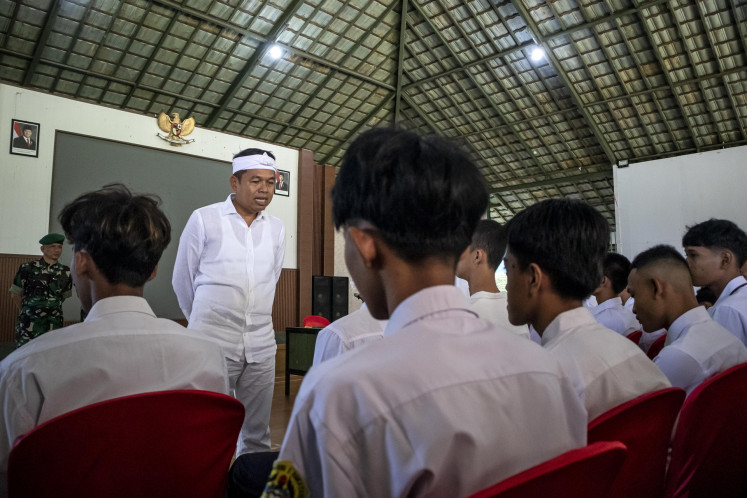New book digs deeper into history of Indonesian cinema
Icons: A photo of Indonesia’s first president Sukarno chatting with Hollywood actress Marilyn Monroe adorns the cover of the new book, Sinema Pada Masa Soekarno (Cinema in the Time of Sukarno)
Change text size
Gift Premium Articles
to Anyone

Icons: A photo of Indonesia’s first president Sukarno chatting with Hollywood actress Marilyn Monroe adorns the cover of the new book, Sinema Pada Masa Soekarno (Cinema in the Time of Sukarno). (Photo courtesy of Sinema Pada Masa Soekarno)
Behind the glitz and glamour of the Indonesian film industry, there are a few passionate individuals who do their work quietly and silently contribute to the preservation of the country’s film history away from the limelight.
The history of Indonesian cinema is the focus of a newly launched book titled Sinema Pada Masa Soekarno (Cinema in the Time of Sukarno) by historian Tanete Pong Masak.
The book was originally a doctoral dissertation written by Tanete in the 1980s when he obtained a scholarship to study the history of cinema at the Ecole Des Hautes Études En Sciences Sociales in Paris, France.
The six chapters of the book discuss different periods of Indonesian cinema.
While the title suggests that the book might only talk about the cinema during the time of Indonesia’s first president Sukarno, it actually provides much more information about the development of film in Indonesian society before Sukarno’s presidential term began.
Tanete wrote the history of Indonesian film from the early 1900s to 1970, the year Sukarno passed away after being held captive by his successor, Soeharto, who took over the presidency in 1967 and became the country’s ruler for nearly 32 years.
The author said the social-political situation during Soeharto’s New Order regime triggered him to write his dissertation on cinema in Indonesia during the time of Sukarno.
“At that time [the New Order period], to talk about anything that took place during Sukarno’s time was prohibited. We were not allowed to talk about Sukarno let alone the stories that took place during his period,” Tanete said during a recent discussion.
“Therefore, I decided to write a dissertation that focused on the history of the cinema when Sukarno was alive and when he was still the president.”
He said it was very difficult to write the dissertation since nobody else had done any research on the history of Indonesian cinema. “Indonesian cinema was perceived as meaningless and insignificant,” he said.
Tanete began his dissertation in the summer of 1980 and he completed it in 1989. During that nine-year period, he spent a lot of time going back and forth between Paris and Amsterdam in the Netherlands to compile documents and recordings of old Indonesian films.
The results of Tanete’s efforts are not disappointing. His dissertation, which has now become a book, is probably the most complete historical archive of Indonesian cinema in the world.
The historical documentation of Indonesian film is evident in the way the book manages to demystify some of the familiar notions about the country’s film history.
For example, Indonesian history books have always referred to Loetoeng Kasaroeng (1927) as the first fiction film to have been produced in Indonesia.
However, Tanete’s research reveals that the first fiction film produced in Indonesia was Mina Het Dienstmeisje In Koopen Doen (Mina the Maid Goes Shopping), which was produced in 1914.
Writer, poet and scriptwriter Seno Gumira Ajidarma said Tanete’s book offered a lot more than just an historical timeline of Indonesian cinema.
He praised the book for its narrative simplicity despite the massive amount of information and knowledge that it delivers.
“Reading the book is like reading a novel. It just flows,” Seno said.
Seno said Tanete had also written an entertaining book by putting in the contextual background and including stories that showed how film had affected Indonesian society and vice versa.
For example, Seno said there were parts of the book that showed how Hollywood clearly had a significant influence not only on Indonesian film, but also on local Indonesian film critics.
“At that time, there was a lack of human resources in the field of film criticism. So, we read reviews that were very simplistic. For example, it is not surprising to see how reviewers at that time deemed a film bad simply by saying it was ‘not Hollywood enough’. These kinds of stories are very interesting,” Seno said.









